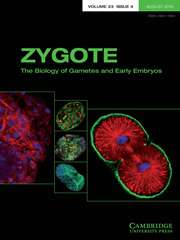No CrossRef data available.
Detection of genome impairment in bovine early embryos by autoradiography: a methodological note
Published online by Cambridge University Press: 14 May 2001
Abstract
The applicability of Pavlok's method characterising the nuclear status ofearly preimplantation bovine embryos by nuclear labelling pattern after ashort pulse of [5-3H]uridine (revealing in situ detection of RNAtranscription at the onset of the major embryonic transcription) wastested on experimentally irradiated 8- to 16-cell bovine embryos. After[5-3H]uridine labelling the semi-thin sections of these embryos wereanalysed by autoradiography for intranuclear distribution of newlysynthesised RNA expected to be influenced by increasing doses ofirradiation by gamma rays from a 60Co source. In control embryos,the labelling was homogeneously distributed in nucleoplasm and innucleoli. The expected effects were clearly detected already inembryos irradiated with a dose of 2 Gy, in which low-level RNAsynthesis was localised mostly at the periphery of the nucleus,the nuclear centre being without labelling. A detailed analysis ofconsecutive sections of embryos from all groups of irradiated andcontrol embryos, using an arbitrary scale considering these effects,confirmed the detectability of the threshold level of genome impairment.
Information
- Type
- Research Article
- Information
- Copyright
- 2001 Cambridge University Press

